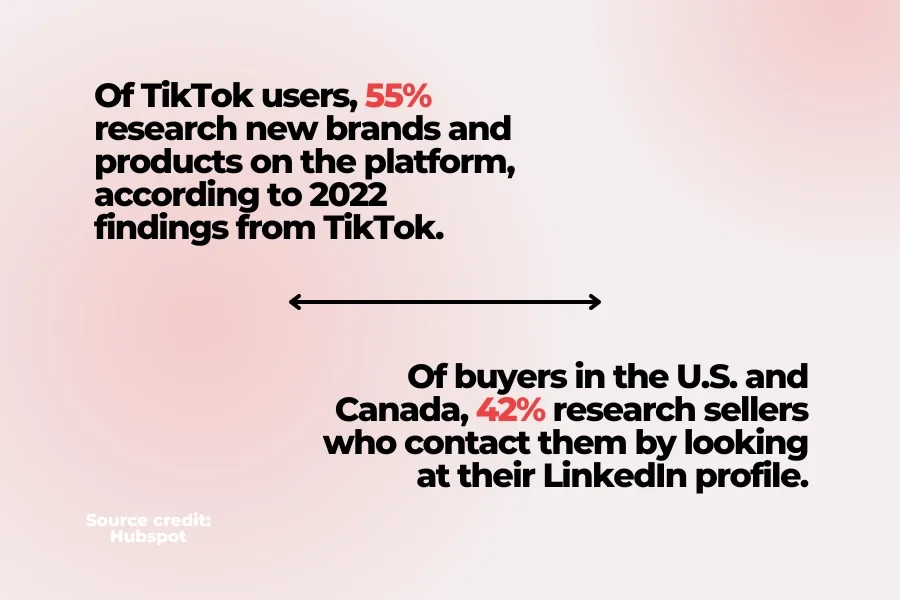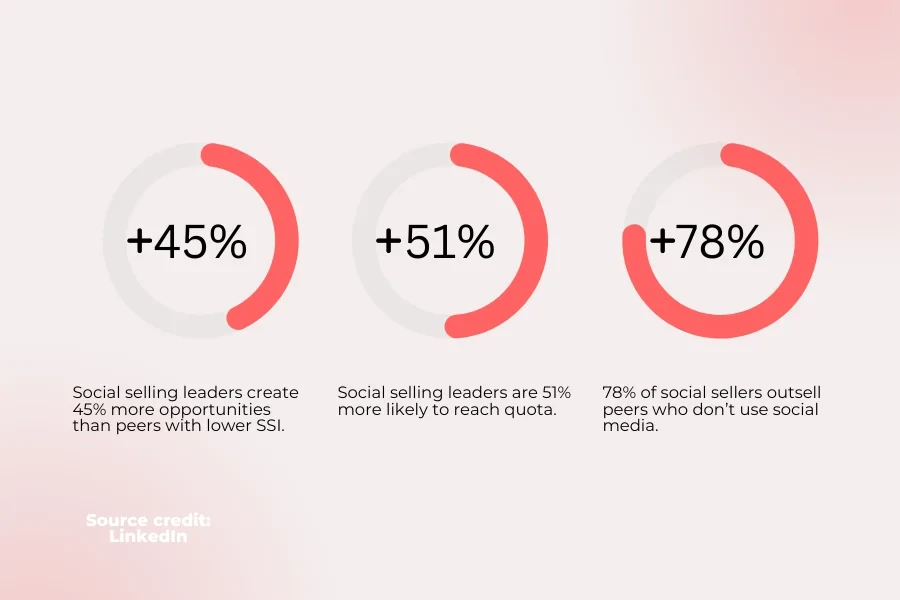Social selling, the art of leveraging social media to engage buyers and drive sales, has become an indispensable tool for modern businesses. As consumers increasingly turn to social media for product research and purchase decisions, companies that fail to adapt risk being left behind. In this post, we’ll dive into some eye-opening stats that showcase the rise of social selling and its potential to revolutionize your sales strategy in 2024 and beyond.
Table of Contents
● The rise of social selling
● Top social media platforms for selling
● B2B social selling landscape
● Proven social selling strategies
● The future of social commerce
● Actionable takeaways
The Rise of Social Selling
Social selling has quickly evolved from a novel concept to a proven strategy for driving business growth. According to HubSpot, a staggering 87% of sellers confirm that social selling has been effective for their business, with 59% reporting increased sales through social media compared to previous years. This trend is further supported by data showing that organizations engaging in social selling report 61% revenue growth.
The power of social selling lies in its ability to foster genuine connections with potential buyers. By leveraging social media platforms, sales professionals can build trust, establish thought leadership, and provide value to their target audience. In fact, sales professionals who use social selling close 40-50% more new business than those who don’t, as reported by LinkedIn.
While social selling complements other sales channels, it has become an essential component of a well-rounded strategy. HubSpot found that 94% of social sellers also sell on their own website or a third-party online marketplace, highlighting the importance of a multi-channel approach.
As the effectiveness of traditional sales methods wanes, businesses must embrace social selling to remain competitive. With over 50% of social sellers considering audience targeting a key benefit, the ability to reach the right people at the right time has never been more crucial.

Top Social Media Platforms for Selling
With numerous social media platforms available, it can be challenging to determine which ones to prioritize for social selling. According to HubSpot’s 2023 data, Facebook emerges as the most trusted social shopping platform overall, with consumers rating it as having the best in-platform shopping experience.
YouTube secures the second spot in terms of trust, while Instagram takes third place. However, when it comes to in-app shopping experiences, Instagram ranks second, followed by YouTube in third. Interestingly, while TikTok is the least trusted platform for in-app purchases among consumers overall, Gen Z actually prefers it, signaling a shift in younger generations’ shopping habits.
The effectiveness of these platforms for social selling is further demonstrated by platform-specific statistics. For instance, interacting with customers in Instagram DMs converts 70% of the time, and product tagging on the platform increases sales by 37%. On Facebook, around 1 million users make purchases every month, with Facebook Shops boasting an impressive 1 billion monthly active users across more than 250 million shops worldwide.
TikTok’s influence on social spending continues to grow, surpassing $250 million in the U.S. alone. The platform’s engaging format proves highly effective, with 92% of TikTok users inspired to make purchases after watching an ad.
As social commerce sales worldwide are forecasted to reach a staggering $8.5 trillion by 2030, businesses must strategically select and optimize their presence on the platforms that best align with their target audience and goals.

B2B Social Selling Landscape
While B2C businesses have readily adopted social selling, the B2B landscape is also witnessing a significant shift towards this approach. LinkedIn’s research reveals that 75% of B2B buyers use social media to make purchasing decisions, emphasizing the importance of a strong social presence for B2B sellers.
The impact of social selling on B2B revenue is undeniable. According to LinkedIn, 78% of businesses that use social selling outperform those that don’t, and companies prioritizing social selling are 51% more likely to reach their sales quotas.
LinkedIn emerges as a powerhouse for B2B social selling, with sales professionals boasting a strong social selling index on the platform having 45% more sales opportunities. Moreover, audiences exposed to brand messages on LinkedIn are six times more likely to convert. In one study, 31% of sales reps using social selling on LinkedIn reported closing deals worth over $500,000 without a single in-person meeting.
B2B buyers increasingly expect a seamless, digital-first experience. In the U.S. and Canada, 42% of buyers research sellers who contact them by looking at their LinkedIn profiles. Additionally, 89% of B2B marketers already use LinkedIn to generate leads, recognizing the platform’s potential for driving business growth.
As the B2B social selling landscape continues to evolve, businesses that adapt and leverage these powerful platforms will be well-positioned to build relationships, establish trust, and ultimately close more deals.

Proven Social Selling Strategies
To maximize the impact of social selling, businesses must employ data-backed strategies and best practices. Personalization has emerged as a key driver of success, with 94% of marketers confirming that it boosts sales. By tailoring content and interactions to individual buyers, sellers can forge stronger connections and increase conversion rates.
Video content has also proven to be a game-changer in social selling. Short-form video formats, such as TikTok, Instagram Reels, and YouTube Shorts, provide the biggest ROI for marketers. For long-form marketing videos, the optimal length is between 3-6 minutes, striking a balance between engagement and information delivery. The power of video is evident, with 82% of consumers stating that they have been convinced to make a purchase after watching a brand’s video.
Engaging with user-generated content (UGC) is another effective strategy. While consumers may not fully trust social shopping yet, UGC can help bridge the gap. An impressive 87% of businesses report that UGC increases their sales, and 92% say it boosts brand awareness. To encourage customers to post UGC, 64% of social sellers rank active community engagement as the most effective method, followed by incentives such as discounts and rewards.
Building an active community is crucial for social selling success. In fact, 45% of sellers consider the ability to build and engage with a community as the most important feature a social media platform should have for social selling purposes.
By implementing these proven strategies and staying attuned to the ever-evolving social media landscape, businesses can optimize their social selling efforts and drive meaningful results.

The Future of Social Commerce
As social media continues to shape consumer behavior and preferences, the future of social commerce looks incredibly promising. Consumer behavior is shifting, with 71% of consumers now preferring to gather information themselves when researching a product or service, according to HubSpot’s 2024 State of Sales report. This trend is further supported by the fact that 96% of sales professionals found that when they first speak to a prospect, the buyer has already conducted research on the product or service of interest.
Younger generations, in particular, increasingly turn to social media platforms to discover and purchase products, rather than relying on traditional search engines. This shift in behavior is expected to accelerate, with social media projected to drive $1.2 trillion in transactions by 2025, as reported by Accenture.
As social commerce continues to evolve, businesses must adapt to meet the changing expectations of their customers. This includes investing in seamless in-app shopping experiences, leveraging emerging technologies such as augmented reality and virtual reality, and partnering with influencers to reach new audiences.
Actionable Takeaways
To capitalize on the potential of social selling, businesses should:
- Prioritize the social media platforms that align with their target audience and goals, focusing on those with the highest levels of trust and best in-app shopping experiences.
- Invest in personalization strategies to create tailored content and interactions that resonate with individual buyers, fostering stronger connections and increasing conversion rates.
- Leverage the power of video content, particularly short-form formats like TikTok, Instagram Reels, and YouTube Shorts, to maximize engagement and drive sales.
- Encourage and engage with user-generated content (UGC) to build trust, increase brand awareness, and boost sales.
- Build and nurture an active community on social media platforms, prioritizing features that facilitate community engagement and interaction.
- Stay attuned to the evolving social commerce landscape, adapting strategies to meet changing consumer expectations and leveraging emerging technologies to enhance the shopping experience.
By implementing these actionable takeaways, businesses can effectively harness the power of social selling to drive growth, build lasting relationships with customers, and secure a competitive edge in the ever-changing digital marketplace.
Conclusion
As consumer behavior continues to evolve and social media platforms become increasingly integrated with the shopping experience, businesses that fail to embrace social selling risk being left behind. The time to act is now – embrace the power of social selling and prepare your business for a future where social commerce reigns supreme.




